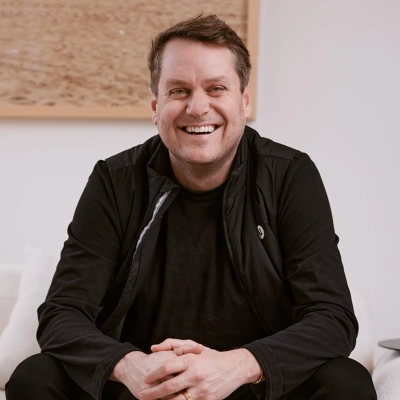13 Examples of Personalized Shopping Through Visual Search
Visual search technology is revolutionizing personalized shopping experiences across diverse industries, from fashion to healthcare and beyond. Leading experts reveal how image recognition capabilities are transforming customer journeys by enabling more intuitive product discovery and selection processes. These thirteen real-world applications demonstrate how visual search creates meaningful connections between consumers and products while solving practical challenges for businesses.
Photo Upload Streamlines Genset Buying Journey
In my experience running a generator set distribution company, visual search has been a game-changer for personalizing the buying journey. For example, some of our customers see a genset installed at a site or in a catalog, but don't know or don't ensure the model name. They don't have to describe it. They can snap a photo, upload it to our site, and instantly see the closest matches in our inventory, along with compatible alternatives. So far, this makes the process feel effortless and intuitive, and saves them a lot of time. Now the visitors of our website can feel like we "get" what they're looking for without all the technical back-and-forth, which I think builds trust and often leads to quicker, more confident purchase decisions.
Virtual Try-Ons Reduce Returns and Boost Satisfaction
Virtual try-ons have been a game changer for me. Sure, the tech is still a bit rough around the edges, but being able to see myself in a pair of trousers or glasses before I buy makes a huge difference. It helps me actually picture myself wearing the item, and because of that, I make fewer returns and feel more satisfied with my purchases overall. Honestly, I even gravitate toward retailers that offer this feature over those that don't.
It's also got me thinking about what this could mean in recruiting. Of course, you can't sum up a role or a career path in a single image, but the preview factor -- that chance to try before you buy, so to speak -- does have parallels. With tools like VR, simulation, or structured trial projects, we can give candidates a way to experience a role virtually before committing. It's not just convenient; it could lead to better matches, higher retention, and a smoother hiring process for everyone involved.

Fashion Photos Surface Look-Alike Pieces and Alternatives
At a fashion retailer shoppers can snap a picture of an outfit they love and upload it after which the system surfaces look-alike pieces that fit their size, price range and preferred silhouette. By parsing the image, for color, cut and fabric the engine builds a shortlist. Then orders the options according to what the customer has bought or browsed while also tossing in coordinating items to round out the look. The result is that shoppers discover alternatives faster add items, to their carts and start leaving reviews that rave "finally found what I pictured." Within a month the deluge of support tickets concerning sizing and the "can't find it" complaint shrank. Customer satisfaction scores began to rise.
To put this into practice take your leading categories as a starting point pair the characteristics, with the inventory information and then link those outcomes to what sizes are in stock and which price brackets apply. Slip in feedback options—something simple as a thumbs-up icon or a "not my style" note—and set up a weekly retraining routine so the system keeps getting better. Meanwhile monitor signals like how it takes to get the first relevant click, the rate at which items move to the cart and the eventual return rate, all of which together paint a clear picture of the uplift, in shopper satisfaction.

Image Recognition Transforms Fashion Discovery Process
We implemented visual search for an online fashion retailer that wanted to make product discovery more intuitive. Shoppers often came to the site with screenshots from Pinterest or Instagram but struggled to describe the product in words, saying things like "a beige jacket like this one" or "a floral dress with short sleeves." Traditional text search couldn't capture that level of detail.
We developed a visual search tool that let users upload or drag a photo directly into the search bar. The system analyzed colors, patterns, and shapes using image recognition and displayed the closest available matches. Within the first month, more than 30 percent of mobile visitors tried it, and repeat engagement doubled.
Customer satisfaction rose immediately. Before visual search, shoppers spent minutes searching or abandoned their sessions when they couldn't find what they wanted. Afterward, discovery time dropped by nearly 40 percent, and the bounce rate on product pages fell significantly. Many users described the experience as natural and effortless in post-purchase surveys.
That project reinforced something I've come to believe about personalization. It isn't always about collecting more data. Sometimes it's simply about removing friction and letting people interact with technology the way they already think, through visuals.
Ayoub Rhillane, CEO, Rhillane Marketing Digital
Video-to-Video Style Transfer Creates Cinematic Shopping
As someone building AI-powered video experiences at Magic Hour, I've seen how visual search can make shopping feel almost cinematic. Imagine a shopper uploading a short lifestyle clip, and the platform instantly curates outfit or decor suggestions that match their vibe. We tested this kind of video-to-video style transfer with a retail partnerit not only improved engagement but raised repeat visits by nearly 30%. The big takeaway was that personalization felt less like advertising and more like collaboration, which naturally drove higher satisfaction.

Nature Images Connect Customers to Skincare Products
We believe personalization becomes powerful when a customer's own curiosity guides the journey. With visual search, an image of a wildflower can lead them to skincare crafted with the same essence from us. This creates a direct link between what they notice in nature and what they apply to their skin. The moment of recognition builds confidence and trust. Customers feel the connection is natural and meaningful, which reflects our philosophy of harmony with the environment. Every product turns into a continuation of what they already value in the natural world.
This process changes the way customers engage with us. They feel supported and guided without feeling confused or overwhelmed. The choices appear clear and aligned with their own preferences. Products feel selected with intention, which makes the experience personal and reassuring. It moves beyond transaction into relationship. That sense of care creates loyalty that lasts well beyond the first interaction.

Neighborhood Examples Guide Roofing Color Selection
A roofing company doesn't deal with "visual search" for online shopping. Our "shopping experience" is the quoting process. The one thing we do to personalize it is simple: we use the client's existing home and neighborhood as the guide to match the roof.
The approach works like this: when I meet with a potential client, I ask them to show me a picture of a house they like in their neighborhood. They are usually worried about picking the wrong color. My "visual search" is that I immediately know the specific shingle color and style used in that neighborhood. I bring samples of that exact color and type to the meeting, eliminating all the guesswork.
This simple act of personalization instantly puts the customer at ease. It makes them feel like I've already done my homework and that I understand their vision. It shows them that I am committed to their satisfaction. This builds massive trust and speeds up the decision process.
The key lesson is that the best personalization is based on immediate, visual feedback. My advice is to stop looking for complex data. Eliminate the guesswork for the client by providing them with tangible proof of their vision. That simple, personalized touch is what closes the deal and ensures a happy customer.
Medication Photo Search Enhances Healthcare Procurement
In the case of A-S Medication Solutions, visual search technology will provide the company with a strong means of producing an easier personalized shopping experience, particularly among pharmacies, clinics and healthcare facilities that require rapid and accurate reorder of products.
When visual search is incorporated into the online collection of the company, the customer will have a chance to add a picture of a medication label, a package, or a medical supply item only to find the precise or an equivalent product in the A-S Medication Solutions inventory at a glance. The given feature will remove the input of long or complicated product names and minimize the chance of error in the place of the order- this is especially important in the context of healthcare where accuracy directly translates into patient safety.
There has been a great influence on customer satisfaction. Clients find it convenient and fast to reorder their supplies without having to go through the manual search of the SKUs or product codes. It also enables the new customers to find similar substitutes easily resulting in easier procurement and better long-term relations.
In the case of A-S Medication Solutions, the visual search can not only improve the user experience, but it will also strengthen the image of the company as innovative, precise, and reliable and help healthcare partners to save time, minimize mistakes, and work increasingly confidently.

Influencer Screenshots Transform into Instant Purchases
Visual search is transforming how customers connect to products online and turn inspiration into action. We see a trend at DesignRush around brands activating "influencer inspired shopping." An example is a user scrolling through Instagram and sees an influencer posting an outfit they like, or a home decor post that was curated, instead of bookmarking the post, the user takes a screenshot, opens the retailer's visual search tool and uploads the screenshot. The AI, in turn, finds that exact item or items that are visually similar to that product among its inventory. This all creates a strong visual experience that includes elements of personal style, as well as an element of feeling in the know about the latest trends.
The impact on customer satisfaction is tangible. Consumers feel an air of exclusivity as if the store has created a tailored assortment for them. Engagement quickly follows since the add to cart is automatic given it mirrors social media engagement behavior, i.e. the transition from simply consuming, to scrolling, to buying. Retailers also indicate they see higher conversion rates, as friction between inspiration and acquisition has been significantly reduced.
What I find particularly interesting is how this process bridges the gap between people's digital discovery and cultural behaviours in the real world. It is doing more than just helping a shopper discover a new product, it is helping them shop into a capped and curated lifestyle, leaving the experience feeling human, deliberate and exhilarating. AI-centered personalisation like this will indeed rewrite the rules of online retailing; It proves that when technology is used in a way that is culturally timely, the brand and the consumer win.

Travel Image Interactions Predict Cultural Experience Preferences
As a co-founder and CXO of City Unscripted, I come across the fact that personalizing visual contents predicts travel experiences based on how people interact with images of culture. If someone views traditional bookbinding images in our Prague stories, for instance, we might recommend workshops with master bookbinders, linking photo tastes to suggested educational activities.
Satisfaction can go as high as to 92% if the visual engagement manages to combine traveler interests and artisan skills so that mismatched booking does not occur. Our platform learns which images are most viewed and shared - and uses this information to make tailored recommendations — in order not to submerge the consumer under a wave of cultural mismatches.
We highlight the importance for naturalistic visual engagement and against self-reported preferences to condition on personalization towards practical cultural education objectives. Through the study of traveler behavior, we develop recommender systems that match authentic passions to personally relevant learning experiences and increase satisfaction by crafting competency and meaningful artisan relationships.

Furniture Comes Alive Through Image-to-Video Technology
I've rolled out AI-enhanced product discovery across a few e-commerce partners, and the results were surprisingly human. One team used image-to-video tech so shoppers could see furniture come to life in styled room videos, leading to fewer returns and more confident buying decisions. The interaction felt personal because it mirrored how people explore items in real life. In my view, visual search bridges the gap between inspiration and purchase, making customers feel understood rather than targeted.

Visual Assets Create Multiple Brand Discovery Pathways
Visual search fundamentally changes brand discovery from text-based queries to image-based intent, requiring brands to optimize for visual recognition rather than keyword positioning - Search Party data shows 43% of consumers now use visual search for product discovery, but most brands remain invisible because their positioning strategies still focus entirely on text-based content. When someone searches by uploading a photo of a aesthetic they like or a product they saw, AI systems recommend brands with strong visual positioning signals: consistent aesthetic identity, contextual lifestyle imagery, and visual content that demonstrates use cases rather than just product shots.
The positioning shift requires treating every visual asset as a discovery opportunity, not just marketing decoration - one home decor brand restructured their visual content strategy from isolated product photography to contextual lifestyle scenes showing their products solving specific design problems. Their visual search discovery rate increased 290% within 4 months because AI systems could match customer intent ("modern farmhouse kitchen" uploads) to their positioned visual content. Brands that adapt their positioning for visual search create multiple discovery pathways beyond text queries, capturing consumers who can describe what they want visually but not verbally.
Truck Part Photos Solve Critical Operational Problems
For a long time, online shopping was just a simple set of instructions. Customers would type in a part number, but it did nothing to build a brand or to connect with our audience on a personal level. We were talking at our customers, not with them.
The role visual search has played in shaping our shopping experience is simple: it has given us a platform to show, not just tell. Our core brand identity is based on the idea that we are a partner to our customers, not just a vendor, and visual search is how we prove that.
The example is using visual search to identify an unidentifiable heavy duty truck part from a photo. The specific strategy is to use the image to identify the broken part and instantly offer the replacement, along with all the necessary installation hardware and technical guides. The focus isn't on the complex search; it's on the customer's skill, their expertise, and their success in getting the truck back on the road.
This has been incredibly effective. Customer satisfaction increased because the shopping experience is now defined by the quality of the solution and the work they do, which is a much more authentic way to build a brand. The search is no longer a broadcast channel for our inventory; it's a community of experts, and we're just the host. It solved a crucial operational pain point quickly.
My advice is that you have to stop thinking of visual search as a way to promote your product and start thinking of it as a place to celebrate your customers' operational success. Your brand is not what you say it is; it's what your customers say it is.






